
* The Mikoyan MiG-29 was one of the Soviet Union's most important combat aircraft in the last years of the Cold War, and remains an important military asset for the successor Russian Republic. It has been widely exported, and updated to keep it in service well into the 21st century. This document provides a history and description of the MiG-29. A list of illustration credits is included at the end.
* In the late 1960s, the US Air Force began work on the development of a next-generation fighter under the "Fighter Experimental (FX)" program. In 1969, McDonnell Douglas won the FX competition with what would become the "F-15 Eagle". The Soviet Union followed the FX program with great interest. Obviously, if the West had improved fighters, the VVS (Voyenno Vozdushniye Sily / Red Air Force) had to have comparable fighters to counter them, and that same year, 1969, the Soviet government issued a requirement for an "anti-F-15" heavy fighter, under the designation "Prospective Frontal Fighter (Perspektivnyi Frontovoi Istrebitel / PFI)".
The PFI was specified as a long-range interceptor to replace older aircraft of that category, such as the Tupolev Tu-128 "Fiddler", the Sukhoi Su-15 "Flagon", and the Yak-28P "Firebar". As a secondary requirement, it was to be used as an escort for long-range strike aircraft such as the Su-24 "Fencer"; or as a long-range intruder to attack Western air assets such as tankers or airborne warning & control systems (AWACS) deep in hostile territory.
The PFI requirements specified an agile aircraft with a top speed of 1,450 KPH (783 knots); a combat radius of 1,700 kilometers (915 nautical miles) at high altitude and 500 kilometers (270 nautical miles) at low altitude; and an operational ceiling of 18,300 meters (60,000 feet). The PFI was to be able to operate from what the VVS called a "Third Class Airfield", with a runway length of 1,200 meters (3,940 feet).
The Mikoyan and Sukhoi design bureaus (OKB) both began work on the PFI specification. The Yakovlev OKB also initiated work on the requirement, but dropped out to pursue the Yak-41 vertical take-off fighter. The Sukhoi design team was led by Yevgeny Ivanov and his deputy, Oleg Samolovich, with inputs from OKB Director General Pavel Sukhoi. Guided by aerodynamic data supplied by the TsAGI (Tsentral'nyi Aerogidrodynamichesky Institut / Central Aerodynamic & Hydrodynamic Research Institute), both the Sukhoi and MiG OKBs designed aircraft with a twin-finned, high-winged, tailed-delta configuration, and using a new armament and fire-control system being implemented by other design bureaus. The main armament was to be the "K-25" air-to-air missile (AAM), which was apparently along the lines of the US Sparrow, but which in fact would never reach production.
It soon became obvious that the agility and range requirements of the PFI specification were incompatible, and so, under the urging of MiG OKB Director General Artem Mikoyan, the PFI specification was split into "Logiky PFI (LPFI / Lightweight PFI)" and "Tyazholyi PFI (TPFI / Heavy PFI)" specifications. This also mirrored American thinking, since the US Air Force had followed their F-15 program with a relatively low-cost "lightweight fighter" effort that would result in the F-16 Fighting Falcon.
Mikoyan was forced to step down as director-general of the MiG OKB after a heart attack, and then died on 9 December 1970. His place was taken by Rostislav Belyakov. Under Belyakov's direction, the MiG bureau went forward on both TPFI and LPFI designs.
The MiG OKB developed a number of TPFI design concepts, but the Sukhoi OKB won the competition for the TPFI requirement, resulting in what would become the Sukhoi "Su-27", discussed elsewhere. The MiG heavy fighter designs were never built. The MiG lightweight fighter design, with the bureau code number "9-11", won the LPFI award, and would become the "MiG-29".
The MiG-29 was to replace MiG-21, MiG-23, Su-7, and Su-17 fighters in the VVS "Frontal (Tactical) Aviation (FA)" component. The primary mission of the MiG-29 was to be battleground air superiority, though it would have a secondary attack role. The development work went forward under a team under Mikhail Waldenburg. The VVS was confident enough in the MiG-29 design to award a production contract along with the development assignment.
* The initial prototype, number "901", performed its first flight on 6 October 1977, with MiG OKB chief test pilot Alexander Fedotov at the controls. It was followed by three more development prototypes, numbered "902" though "904", with shorter nose gear and other changes. The 903 development prototype was lost when its engine caught fire in flight on 15 June 1978, the pilot, Valeriy Menitskiy, ejecting safely. It was replaced by a new "908" development prototype, but ironically this aircraft was lost as well under similar circumstances on 31 October 1980, the pilot, Alexander Fedotov, also ejecting safely.
Western intelligence was aware of the development effort, a US spy satellite having spotted one of the MiG-29 prototypes at the Zhukovsky flight test center in November 1977. Since the proper name of the secret center was not known to Western intelligence at the time, the site was referred to as "Ramenskoye" after the name of a nearby town, and so the mystery aircraft was assigned the designation "Ram-L".
Nine pre-production prototypes, numbered "917" through "925", followed the development prototypes, the last of this series of aircraft performing its initial flight in December 1982. Of course, each successive aircraft in this sequence was closer to full production specification, with the final "925" prototype serving as the model for operational aircraft. Production MiG-29s, built at the Znamya Truda factory in Moscow, went into service with the VVS-FA in June 1983. All the prototypes and production single-seaters had the bureau code number of "9-12". The design was fundamentally the same as that of the original 9-11 concept, though the 9-12 had a longer nose, taller tailfins, and a simplified canopy.
Once Western intelligence acquired reliable details of the new type, the first-generation MiG-29 was given the NATO reporting name "Fulcrum-A". The USSR finally publicly "unveiled" the type to the West with a visit to Finland in July 1986.
BACK_TO_TOP* Following the Finland visit, commentaries on the MiG-29 ran wild in the Western aviation press. Critics sniped that it was a warmed-over rehash of Western designs and technologies, but the reality was that the fighters of the era drew on a similar pool of design concepts, and resemblances between them were almost inevitable.
The 9-12 MiG-29 Fulcrum-A was mostly built of aluminum alloy, with some use of composite materials. The aircraft had a high-mounted wing, all-moving tailplanes, and twin tailfins with a slight outward cant. Flight controls were hydraulic. The wing was blended to the fuselage, with leading-edge root extensions (LERX) and full-span leading-edge maneuvering flaps. There were conventional inboard flaps and outboard ailerons on the trailing edge of the wing. A dive brake was fitted to the back of the aircraft, with another fitted to the belly.
About the first 70 production Fulcrum-As had ventral fins on the bottom of the tail, directly under the tailfins, but they were judged unnecessary and deleted. Chaff-flare dispensers were then added, in the form of distinctive "strakes" fitted on top of the wing as forward extensions of the tailfins. Each dispenser could accommodate 30 chaff cartridges or 30 flare cartridges, for a total load of 60. This addition was a direct consequence of Soviet combat experience in Afghanistan, where American "Stinger" heat-seeking infantry-portable surface-to-air missiles (SAM) provided to the Afghan mujahedin warriors had proven a dangerous threat to Soviet aircraft.
Along with the introduction of the tailfin strakes, small strakes were added to the nose probe, the flight control surfaces were modified to have greater deflection, the tailplanes were given differential action, and the rudders were enlarged, to provide better control at high angles of attack.

The Fulcrum-A was powered by twin Klimov "RD-33" afterburning bypass jet engines, with 49.4 kN (5,040 kgp / 11,100 lbf) dry thrust and 81.4 kN (8,300 kgp / 18,300 lbf) afterburning thrust each. Two engines were selected to improve aircraft survivability. The engines were in separate housings under the fuselage. To permit operation from rough fields, each main intake had a door that closed whenever the main landing gear was in touch with the ground to prevent "foreign object damage (FOD)" from engine ingestion of stones and the like. When the doors were shut, the engines obtained airflow from spring-loaded louvers on top of the wingroots. The transition between the louvers and the front intakes was said to be smooth and almost unnoticeable.
There was a fuel tank in each wing, and five fuel tanks in the fuselage, total fuel capacity being 4,365 liters (1,153 US gallons). The MiG-29 featured tricycle landing gear, the nose gear with two wheels, the main gear with single wheels, all gear assemblies retracting hydraulically forward -- the main gear tucking up into the fuselage inside the wing roots. There was a container between the engine exhausts that stored a cruciform drag parachute.
___________________________________________________________________
MIKOYAN 9-12 MIG-29 "FULCRUM-A":
___________________________________________________________________
wingspan:
11.36 meters (37 feet 3 inches)
wing area:
38.0 sq_meters (409.04 sq_feet)
length:
17.32 meters (56 feet 10 inches)
height:
4.73 meters (15 feet 6 inches)
empty weight:
10,900 kilograms (24,030 pounds)
loaded weight:
18,500 kilograms (40,785 pounds)
max speed at altitude:
2,450 KPH (1,520 MPH / 1,320 KT)
service ceiling:
17,000 meters (55,775 feet)
range (internal fuel):
1,500 kilometers (930 MI / 810 NMI)
___________________________________________________________________
The Fulcrum-A had a built-in single-barreled GSh-301 30-millimeter cannon with 149 rounds firing out the left LERX, for close-in dogfighting and ground attack. The initial prototype had featured a two-barreled GSh-23-2 23-millimeter cannon, but the heavier weapon was adopted for all later MiG-29s.
The aircraft had three stores pylons under each wing, for a total of six. In the air-superiority role, it carried a mix of two "beyond visual range (BVR)" "R-27R / AKU-470" semi-active radar homing (SARH) AAMs, with the NATO reporting name of "AA-10 Alamo-A"; and four "R-60 (NATO AA-8 Aphid)" AAMs or "R-73 (NATO AA-11 Archer)" heat-seeking short-range "dogfighting" AAMs.
The R-73 / AA-11 Archer was one of the first "off-boresight" AAMs. It was regarded as agile, with good counter-countermeasures, and far superior to the antiquated R-60 / AA-8 Aphid, which was only carried by Soviet MiG-29s early on. However, export users rarely got the R-73 and had to make do with the R-60. The Fulcrum-A could also occasionally carry a single long-range "R-27B (NATO AA-10 Alamo-B)" heat-seeking missile in place of one of the R-27R / AA-10 Alamo-As. The Alamo-B allowed long-range attacks without requiring telltale radar emissions from the launch aircraft.
The outboard pylon on each wing was reserved for AAMs and could not be used to carry attack stores. A 1,500-liter (396 US gallon) external tank could be mounted on the centerline for ferry flights. Although the Fulcrum-A lacked the combat avionics systems for the strike role, it could carry dumb bombs and unguided rocket pods, and it is believed that some MiG-29 squadrons were equipped with the RN-40 tactical nuclear weapon.
The Fulcrum-A featured a SUO-9 weapons control system, which featured:
The system was effective, but not the equal of contemporary Western counterparts. Pilot workload was high by Western standards -- though this was not seen as a major problem, since Soviet doctrine relied on "ground controlled intercept (GCI)" tactics, with the aircraft being guided to a target semi-automatically by a ground station, the pilot more or less merely acting as a supervisor. The only defensive countermeasures system was a radar warning receiver (RWR); active jammers could be carried externally.
Cockpit layout for the Fulcrum-A was generally regarded as middling to poor, even by the standards of its era. It had an analog layout, though it did feature a head-up display (HUD) and limited "hands on throttle & stick (HOTAS)" controls. In some compensation, the MiG-29's cockpit layout did have a clear evolutionary relationship with those of the MiG-21 and MiG-23, easing pilot conversion.
In another compensation, a Fulcrum-A pilot sat on one of the best ejection seats in the world, the rocket-boosted Zvezda "K-36D" seat with "zero-zero (zero speed, zero altitude)" capability. The West got an impressive demonstration of the K-36D at the Paris Air Show in 1989, when pilot Anatoliy Kvotchur had to leave his MiG-29 in a big hurry after losing an engine due to a birdstrike. The ejection seat got him out neatly in the split second before the aircraft smashed into the ground and became a fireball.
* The Fulcrum-A was very agile, though since it lacked the advanced "fly-by-wire (FBW)" flight controls of its Western counterparts, that meant it placed a premium on pilot skill. Flight controls had "soft limits", allowing the pilot to exceed recommendations if needed. However, the MiG-29 was not an unfriendly machine either, giving plenty of warning before departing controlled flight. It also did not spin easily, and a spin could almost always be easily corrected by neutralizing the controls. The MiG-29 had good handling at low speeds and remained controllable at very high angles of attack.
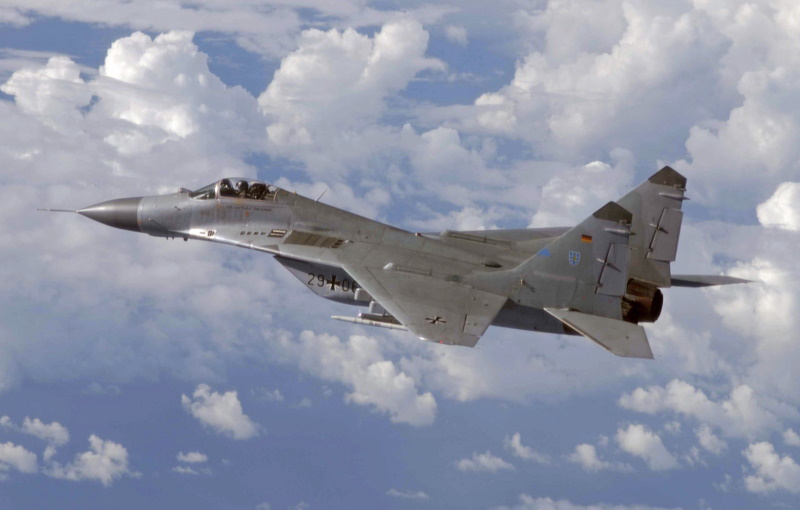
The Fulcrum-A was regarded as more agile than its Western counterpart, the F-16A, and was a particularly dangerous adversary in a low-speed turning fight. Its biggest limitation was poor range, sometimes being described as a "fighter for use over the airfield beacon".
Two subvariants of the MiG-29 Fulcrum-A were built:
Both retained the "Fulcrum-A" reporting name. Exports were from 1987.
BACK_TO_TOP* Although the MiG-29 was basically docile, it was still a high-performance aircraft; the MiG OKB accordingly developed a tandem two-seat operational conversion trainer, designated "9-51 MiG-29UB". First flight of the initial prototype was on 29 April 1981, with Fedotov at the controls.
The second cockpit was not raised significantly, since that would have degraded performance. As a result, the back-seat instructor had a poor forward view, but was provided with a periscope that popped up when the landing gear was extended to provide a better forward view. Some fuel capacity was deleted to make space for the back-seat cockpit. Since the MiG-29UB was not intended to be combat-capable, the chaff-flare dispenser strakes were not fitted, and the N019 radar was replaced by a onboard simulator unit. The MiG-29UB had the 30-millimeter cannon and could launch heat-seeking AAMs but not radar-guided AAMs, and had no target tracking capability. Removal of the radar gave the MiG-29UB a smaller nose that arguably improved its appearance.
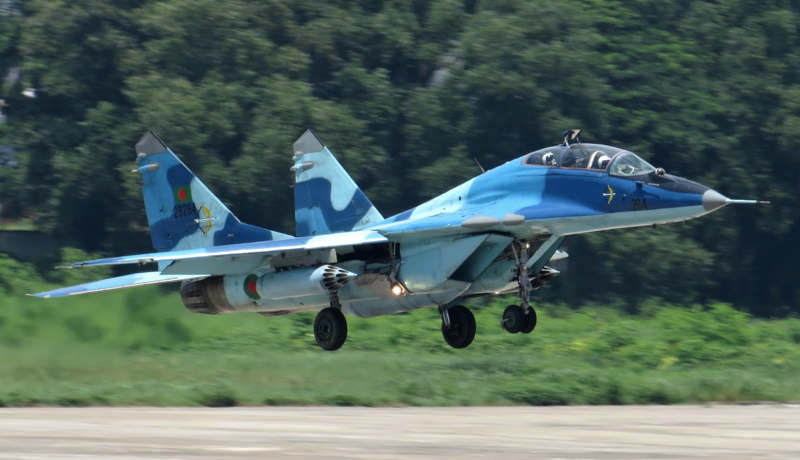
The "UB" suffix was misleading, since it stood for "Uchebno-Boevoi (Trainer-Combat)" when the variant was really a full-time trainer. NATO swallowed this misinformation, giving the type the reporting name "Fulcrum-B" instead of assigning it the "M"-series reporting name normally given to trainers, such as "Midget" for the MiG-15UTI or "Mongol" for the MiG-21UB. Russian crews called the MiG-29UB the "Sparka (Twin)", a general name for a two-seat trainer.
* While the 9-12 MiG-29 Fulcrum-A was going into volume production, the MiG bureau had been considering a refinement of the type, the "9-13", with tests of kit on various modified Fulcrum-As leading to the first flight of a new-build prototype in 1986. The new variant retained the "MiG-29" designation, but it seemed visibly different enough from the original Fulcrum-A variant to be given a new reporting name of "Fulcrum-C" by NATO. The main difference was a swollen spine, which led Soviet MiG-29 pilots to call the Fulcrum-C the "Gorbatyi (Hunchback)".
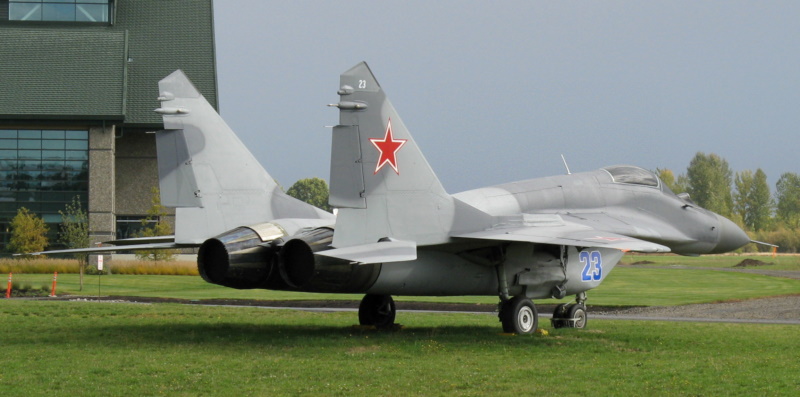
Western analysts interpreted the Fulcrum-C's swollen spine as accommodation for increased fuel capacity to improve on the Fulcrum-A's limited range. In fact, the fuel capacity increase of the Fulcrum-C was modest -- 240 liters (63 US gallons), and most of the expanded space was used to house a Gardeniya active jammer module. The updated avionics suite also led to modifications of the wingtips and addition of antennas to the tail. About 200 Fulcrum-Cs were built, with initial introduction to service in 1986. They were not exported, due to worries over the security of the countermeasures system.
BACK_TO_TOP* The first-generation MiG-29 and MiG-29UB were exported to many Eastern European nations, countries flying the type including Bulgaria, Czechoslovakia, East Germany, Hungary, Poland, Romania, and Yugoslavia. After the breakup of Yugoslavia, Serbia inherited the ex-Yugoslavian MiG-29s.
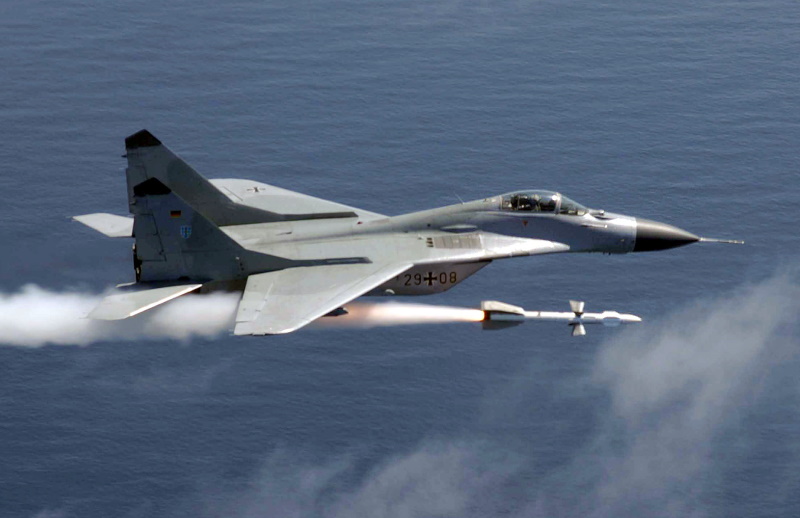
African nations that obtained early MiG-29s -- in some cases through later hand-me-down transfers -- included Algeria, Chad, Eritrea, and Sudan; Middle Eastern nations included Iraq, Iran, and Syria. The Indian Air Force (IAF) was an early export user of the MiG-29, having obtained 70, including 5 two-seaters, from 1985 -- as early adopters they suffered from some technical problems, but they were eventually resolved.
Other Asian nations that obtained the MiG-29 included Bangladesh, Malaysia, Mongolia, Myanmar, and North Korea. The only New World nations to obtain the MiG-29 for operational service were Cuba and Peru.
With the breakup of the USSR in 1991, substantial numbers of MiG-29s were passed on to other "successor states" of the Former Soviet Union -- including Azerbaijan, Belarus, Kazakhstan, Moldova, Turkmenistan, Ukraine, and Uzbekistan. There have also been sales of improved MiG-29 variants and upgrades of older machines, as discussed below.
East German MiG-29s actually flew for a time with the Luftwaffe of the reunited Germany, not just for aggressor training but for first-line operational service; they were given some updates, but were out of service by 2006. The Luftwaffe upgrades were among the first and led to the establishment of a new unified service organization, the "MiG Aircraft Product Support (MAPS) Group".
The Czech Republic and Hungary retired their MiG-29s, replacing them with the SAAB JAS 39 Gripen; Poland partly replaced their MiG-29s with the F-16, but updated others to keep them in service. Bulgaria, Romania, Serbia, the Slovak Republic, and Ukraine also updated their machines to keep them in service. Following the Russian invasion of Ukraine in early 2022, Ukrainian Air Force MiG-29s played a significant role in the conflict, primarily in air defense against Russian cruise missiles. They were also qualified with Western stores -- notably the AGM-88 High-speed Anti-Radiation Missile (HARM), and used in the defense suppression role. MiG-29s were transferred to Ukraine from other users in Eastern Europe, with 12 promised by Poland and 13 by Slovenia. Russian MiG-29s saw little or no action.
The US obtained 21 MiG-29s from Moldova, it seems primarily to keep them from being sold to Iran. What happened to them is not clear, though at three MiG-29UBs were obtained by an American firm named "Air USA" to fly as "aggressors" in military training exercises.
BACK_TO_TOP* The MiG OKB continued to make further tweaks that resulted in the "9-13S" AKA "MiG-29S", which retained the NATO "Fulcrum-C" reporting name, since external appearance remained largely unchanged. The MiG-29S featured a modernized "N-019M Topaz-M" radar, an Is-101M processor, an improved jammer, and a refined flight control system to improve agility. It also had "wet" inboard pylons that could carry a 1,150-liter (303 US gallon) external tank, complementing the centerline tank. Only 16 MiG-29S machines were built, going into service with the VVS.
De-tuned variants were offered for upgrades, including the "MiG-29SD" and "MiG-29SE". Malaysia upgraded their surviving MiG-29s to MiG-29SD standard. These machines retained the original MiG-29 spine and featured an optional bolt-on refueling probe.
There was also an effort to produce a true "multirole" MiG-29, which emerged as a series of "MiG-29M" demonstrators. The first, the "9-14 MiG-29M", flew in 1985, and was essentially a Fulcrum-C modified to carry a targeting pod for ground attack. The second was the "9-15 MiG-29M", which was much more extensively redesigned. The initial flight of a 9-15 MiG-29M was 26 April 1986, with Valeriy Menitsky at the controls. This aircraft was followed by a machine closer to full spec, which performed its initial flight on 1 November 1989. It featured:
The sensor system enhancements made the 9-15 MiG-29M a true multirole aircraft. It was fitted with a total of eight stores pylons, four under each wing, as opposed to the total of six of previous MiG-29 variants. The wings were reinforced to carry a total warload of 4,500 kilograms (9,920 pounds). The two inboard pylons on each wing could carry a maximum of 1,000 kilograms (2,200 pounds) each, while the two outboard pylons could carry up to 500 kilograms (1,100 pounds) each. In addition to stores carried by the earlier variants, the MiG-29M could carry "smart" weapons. Typical smart munitions included:
The MiG-29M could also carry the advanced "R-77 (NATO AA-12 Adder)" AAM -- export designation "RVV-AE" -- sometimes referred to as the "AMRAAMski", since it was comparable to the US AIM-120 AMRAAM missile. The R-77 had a range of about 100 kilometers (60 miles), and a fully active radar seeker for "fire and forget" operation.
* Six 9-15 MiG-29M demonstrators were flown, but the type did not enter production for the VVS. The development of the MiG-29M coincided with the collapse of the Soviet Union, effectively shutting down MiG-29 production. By that time, 620 Fulcrum-A and 528 Fulcrum-C single-seaters had been built, as well as 197 Fulcrum-B trainers. The halt in production meant many unfinished airframes were left at the factories, which provided a feedstock for future sales.
The VVS focused on the Su-27 during the Yeltsin era. Both the MiG-29 and the Su-27 were air-superiority fighters, and the MiG-29 wasn't that much cheaper; the Su-27 was the obvious preference. The MiG-29M effort sputtered along on various hopes into the mid-1990s, and then finally went into limbo. Attempts to promote an export version were not successful.
* The MiG OKB also developed a carrier-based advanced MiG-29 variant, the "9-31 MiG-29K", in parallel with the MiG-29M. The MiG-29K could be considered a "navalized" 9-15 MiG-29M, differing in the fit of:
Production aircraft were to have a fully automatic carrier landing system. Work on the MiG-29K began in 1984. The initial development prototype was modified from an older MiG demonstrator and designated the "MiG-29KVP". It lacked folding wings and double slotted flaps, and may not have had ruggedized landing gear. The MiG-29KVP was used to demonstrate arrested landings, as well as "ski-jump" takeoffs, as the Soviets were having troubles developing catapult systems for the carriers they were building. Tests were apparently mostly conducted on a land-based replica of a carrier deck in the Crimea, since it could not perform a true carrier landing without reinforced landing gear. The first flight of a true MiG-29K prototype was on 23 June 1988. It was followed by a second prototype in 1990.
The fall of the USSR meant the MiG-29K also didn't enter production, at least at the time. A two-seat trainer, with a stepped independent rear cockpit for the flight instructor to provide an adequate view on steep carrier landings, was considered but not built.
BACK_TO_TOP* The failure of the MiG-29M and MiG-29K to enter production meant lean times for the MiG OKB, whose fortunes seemed to be on a steady decline in the new Russia. Outside observers wondered if the great name of MiG might be headed for extinction, as it steadily withered during the 1990s while the Sukhoi organization was awarded new fighter contracts. The only business was in "MiG-29SM" upgrades of existing aircraft, this being a modest update to add air-to-ground capabilities, initially with TV-guided missiles and bombs being carried, their seeker imagery fed into the cockpit display.
Carriage of the "Kh-31A/P (NATO AS-17 Krypton)" supersonic antiship / antiradar missile, and the "Kh-35 (NATO AS-20 Kayak)" subsonic antiship missile, was added later, with the N019M radar updated to "N019MP" to permit ground-attack / ship-attack targeting, and a Pastel RWR coupled with an external pod to permit targeting of radar "emitters". The MiG-29SM was just a start, however, with the new "Rossiskaya Samoletostroitelnaya Korporatsiya MiG (RSK MiG)" organization moving on to promote a range of improved MiG-29 variants.
While a ground-up redesign like the MiG-29M was out of the question, major improvements could be made with less drastic changes that could be implemented in either new-build aircraft or as upgrades to existing aircraft. The VVS wanted to upgrade over 400 existing MiG-29s, providing a strong incentive.
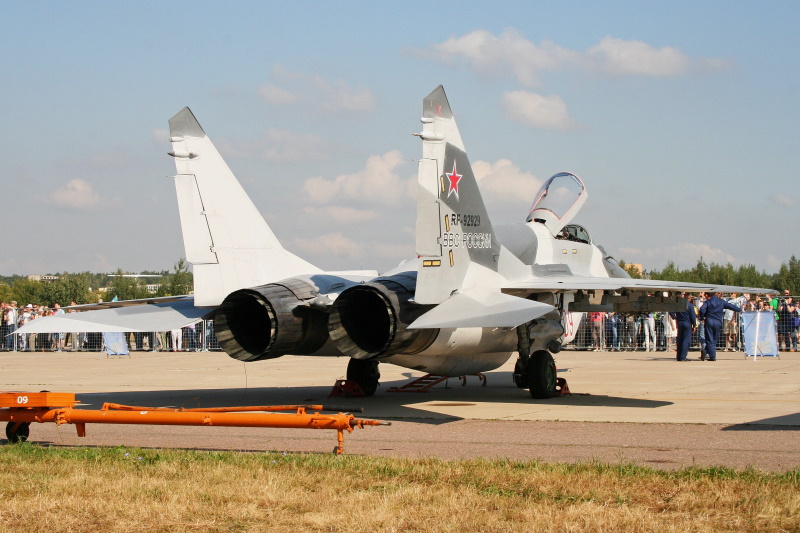
The result was the "9-17 MiG-29SMT", which could be considered a revival and extension of the various MiG-29S upgrade efforts of a few years earlier. The MiG-29SMT featured a "glass cockpit" based on that of the MiG-29M, but with twin 15 by 20-centimeter (6 by 8-inch) full-color flat panel LCDs, instead of the smaller monochrome CRTs of the MiG-29M, as well as two smaller monochrome LCDs. Modern HOTAS controls were implemented as well, and the MiG-29SMT also featured a MIL STD-1553B compatible digital databus to link the cockpit and the avionics systems. An advanced navigation system, using laser gyros and a satellite positioning system receiver, was fitted, as well as built-in diagnostic systems to ease maintenance.
To deal with the range issue, the MiG-29SMT featured a particularly swollen "hunchback" spine, featuring two fuel tanks, one with a capacity of 1,400 liters (370 US gallons) and 480 liters (127 US gallons). That increased fuel load by 30% over the baseline MiG-29; the MiG-29 SMT could also be fitted with a bolt-on inflight refueling probe. The spine terminated in a beavertail like that of the MiG-29M, which could accommodate one or two parachutes, as required by aircraft load.
The MiG-29SMT retained the top-and-bottom airbrake scheme of the Fulcrum-A, though the dorsal airbrake was larger, and also retained the old scheme of chaff-flare dispenser strakes. Old MiG-29s upgraded to the MiG-29SMT specification were to be refurbished to give them 20 years of airframe life.
Unrefueled range of the MiG-29SMT was cited as 2,200 kilometers (1,370 miles) without external tanks, almost half again as great as that of Fulcrum-A. Multirole capabilities were provided by an improved N019M radar, with greater range, wider field of view, and the ability to track ten targets at once. External targeting and reconnaissance pods could also be carried. The MiG-29SMT could use all the advanced weapons that were qualified for the MiG-29M, with a total external stores load of 4,000 kilograms (8,800 pounds) on six stores pylons. Although early MiG-29SMTs retained the old RD-33 engines, full-specification machines were to be fitted with more powerful Klimov "RD-43" engines with over 10,000 kilograms (22,000 pounds) afterburning thrust.
Initial flight of the first MiG-29SMT prototype was on 29 November 1997, with Marat Alykov at the controls. This machine was a modification of a company demonstrator that had already been used in the earlier MiG-29S effort, and did not include all the features expected for the "production" MiG-29SMT. The first full-standard MiG-29SMT, also a conversion of a company demonstrator, performed its first flight on 14 July 1998, piloted by the MiG organization's new chief test pilot, Vladimir Gorbunov. This aircraft was demonstrated at the Farnborough Air Show in the UK in 1998.
RSK MiG followed up the MiG-29SMT with a similar effort to produce a second-generation two-seater, the "9-51T MiG-29UBT", essentially a company 9-51 MiG-29UB fitted with improvements developed for the MiG-29SMT.
The MiG-29UBT featured the swollen spine to store more fuel, with the larger dorsal airbrake and the beavertail of the MiG-29SMT, and also could be fitted with a bolt-on inflight refueling probe. The front-seater's cockpit layout was very much like that of the MiG-29SMT; the back-seater still had flight controls, but the rear panel layout also featured a large CRT to display TV or infrared camera imagery provided by external pods. While the MiG-29UBT could be used as a trainer, its focus was clearly for roles such as precision strike, with the back-seater targeting and guiding smart munitions while the pilot flew the aircraft. No radar system was fitted to the MiG-29UBT demonstrator, but production machines were to be fitted with an advanced multimode radar.
RSK MiG saw the MiG-29SMT as a demonstrator for a "Chinese menu" of possible upgrades, ranging in sophistication from a simple airframe overhaul with fit of a refueling probe and low-cost avionics improvements -- to the full-blown MiG-29SMT configuration, possibly even adding the high-end N-010 Zhuk-M radar.
Yemen was the first to obtain the MiG-29SMT / UBT, ordering up to 18 single-seaters and two two-seaters, with initial deliveries in 2004. These were new-build aircraft, but didn't have the hunchback. Sudan then ordered 12, and Eritrea 2 in the same configuration. Algeria ordered 28 "hunchbacks" in 2007 -- but after 15 were delivered, the Algerians found out the aircraft contained used parts. Since they had been sold as new, the Algerians terminated the contract and returned the aircraft. Syria ordered four upgrade kits in 2011, while Peru ordered 12 in 2012.
The path towards upgrade of Russian MiG-29s was torturous. Limited funding kept the VVS from making any commitment to upgrades for years, but in 2005, with the economy doing fairly well from oil exports, the service decided to begin an upgrade of the MiG-29 fleet, focused on adding a strike capability. This upgrade actually featured avionics developed for the Su-30 / Su-27 upgrade to reduce cost and logistical overhead, and retained the old N-019 radar with some upgrades. The airframes were overhauled and reinforced to carry heavier warloads.
The VVS also obtained 28 new-production MiG-29SMT fighters in 2009 and 2010, these being the machines been built for Algeria and returned. The VVS ordered 16 more single-seaters and four more two-seaters in the spring of 2014, as a first installment on a buy of 100 machines, with initial delivery at the end of 2015.
BACK_TO_TOP* Although the MiG-29K carrier-based fighter didn't go anywhere for years, the Indian Navy finally obtained it, with India funding work on single-seat and two-seat pre-production machines, the two aircraft first flying in 2007. The two-seater was lost in a crash in 2011, both aircrew being killed, with a replacement built, which was lost in a crash in 2015, one aircrew being killed.
The Indian Navy ordered 12 "MiG-29K" single-seaters and four "MiG-29KUB" two-seaters. The first production-standard machine performed its initial flight in 2008, with deliveries in 2009:2011. They operated off the carrier VIKRAMADITYA -- formerly the ADMIRAL GORSHKOV, which India purchased from Russia. The carrier was refurbished, being given a "ski jump" deck, and went into service with the Indian Navy in 2013. Exercising an option in the initial contract, the IN bought 29 more machines in 2010, with deliveries from 2012 to 2016.
The IN MiG-29K could be described as a MiG-29SMT with the navalization features of the original MiG-29K, such as longer, folding wings; arresting gear; stronger landing gear to handle heavier warloads; airframe corrosion protection; and eight stores pylons. The inner four pylons were "wet" and could carry 1.150-liter (303 US gallon) external tanks, while a 2,200-liter (580 US gallon) tank could be carried on the centerline. Internal fuel capacity was raised to 7,300 liters (1,925 US gallons). The MiG-29K could carry a "PAZ-1MK" tanker pod.
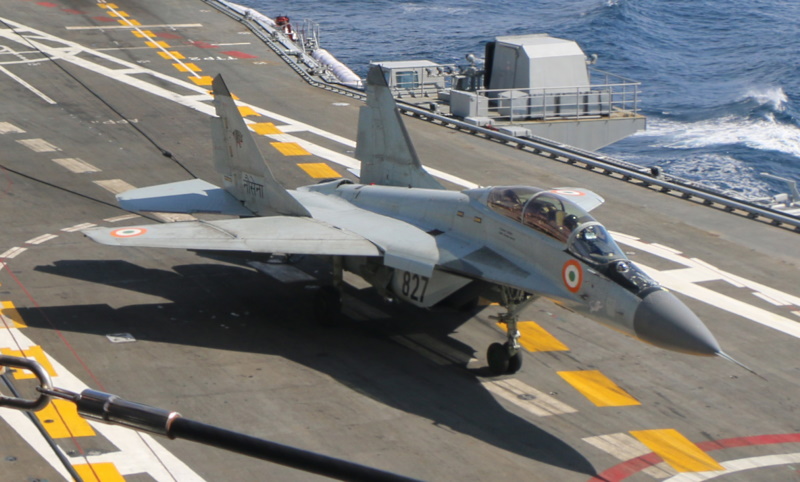
The IN MiG-29K featured folding tailplanes and a folding nose radome to further reduce the aircraft's deck footprint. Both the prototypes for the IN MiG-29K were actually modifications of the two original MiG-29K prototypes. Production aircraft used an uprated, corrosion-protected "RD-33-10M" bypass jet with 4.76 kN (10,500 kgp / 23,150 lbf) thrust. The IN MiG-29K also featured:
The MiG-29UBT was generally similar to the MiG-29K aside from the tandem cockpit. Fit of the second seat eliminated a 630-liter (65 US gallon) fuel tank, reducing internal fuel capacity by about 7%.
From 2008, 62 of India's MiG-29s were upgraded, being fitted with avionics comparable to that of a MiG-29SMT, but with more foreign content. The kit included Zhuk-2ME radar; a Russian OLS-USM electro-optical / infrared search & track sensor; Thales Topsight helmet-mounted sight / display; Electtronica Virgilus RF jammer; Indian Tarang Mark II radar homing & warning system; and Indian Bharat Dynamics chaff-flare dispensers.
The upgrade also included "RD-33-3M" engines and carriage of the latest munitions. The first six machines were upgraded in Moscow, the rest were upgraded by HAL in India. Initial flight of the first upgrade was in 2011, with initial redeliveries in late 2012. The IAF ordered 21 refurbished and upgraded MiG-29s in 2019 to flesh out a new squadron.
* In 2012, the Russian Navy placed an order for 20 "MiG-29KR" fighters and four "MiG-29KUBR" two-seaters, for operational service on the Russian Navy's sole aircraft carrier, the ADMIRAL KUZNETSOV. These machines were similar to their Indian Navy equivalents, but used Russian instead of foreign avionics; deliveries began in late 2013, being completed in 2015.
The VKS -- "Vozdushno-Kosmicheskiye Sily / Russian Aerospace Force", as the VVS became in 2015 -- obtained the "9-41SR MiG-35S" single-seater and "9-47SR MiG-35UB" two-seater, derived from the MiG-29K series. The MiG organization worked to enhance the type, having unveiled a next-generation MiG-35 at the Moscow MAKS airshow in 2019. The revised aircraft featured:
Following two pre-series machines, six pre-production / evaluation machines were built, with the six evaluation machines obtained by the VKS. An export version was offered, being simply designated "MiG-29M", complemented by a "MiG-29M2" two-seater. 12 were ordered by Syria, but never delivered because of the civil war there. Egypt ordered 46 in 2015, with deliveries in 2017:2021; Algeria ordered 14 in 2019, with deliveries in 2020:21. The MiG-29M differed from the MiG-35 in having detuned avionics of mostly Russian origin. These MiG-29 variants of course carried modern munitions, including:
According to the MiG organization, over 1,600 MiG-29s were built. The VKS decided to use the MiG-29 as a training asset, the service preferring the Sukhoi Su-30 fighter. The MiG-29 was not that much cheaper than the Su-30, and the Su-30 was more capable. As it turned out, the six MiG-35s were the only ones delivered to the VKS.
MiG-29 upgrades have also been performed outside of Russia. Ukraine's MiG-29 fleet deteriorated in the post-Soviet era, but tensions with Russia drove an upgrade program, with Ukrainian MiG-29s given a "MiG-29MU1" upgrade, with initial redeliveries in 2011. The primary improvements were a more powerful N019-19 radar with greater range, an updated navigation system, and a modernized defensive avionics system. A phase-2 "MiG-29U2" update was introduced in 2019, featuring further updated communications, navigation, and weapons-management systems; it supported modern smart munitions.
BACK_TO_TOP* I've long liked the MiG-29, and I was inspired to write about it when I bought a 132nd-scale diecast model of it from Postage Stamp Planes. It was a cheap item and I couldn't pass it up. As it turned out, once I'd waded through the MiG-29's history, the model was a bit peculiar. It was a MiG-29UB with AAMs, fitted with a mixed load of AA-8, AA-11, and AA-10 AAMs -- which was a somewhat odd configuration, never mind that the MiG-29UB wasn't supposed to be combat-capable. The AAMs were very nicely done for the small scale, and the whole thing is still a pretty little piece and a good buy for the price.
* Sources include:
* Illustrations credits:
* Revision history:
v1.0.0 / 01 mar 02 v1.0.1 / 01 may 02 / Review & polish. v1.0.2 / 01 jun 02 / Added comments on the loss of PAK-FA. v1.0.3 / 01 jul 04 / Review & polish. v2.0.0 / 01 apr 07 / General rewrite and cleanup. v2.0.1 / 01 may 09 / Review & polish. v2.0.2 / 01 may 10 / Review & polish. v2.1.0 / 01 apr 12 / Russian Navy MiG-20K buy, cut comments on MiG 1.44. v2.1.1 / 01 mar 14 / Review & polish. v2.1.2 / 01 feb 16 / Review, polish, & update. v2.2.0 / 01 jan 18 / Review, polish, & update. v2.2.1 / 01 dec 19 / Review, polish, & update. v2.3.0 / 01 oct 21 / Some rewrite. v2.4.0 / 01 oct 23 / Review, polish, & update. (*)BACK_TO_TOP
